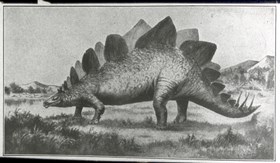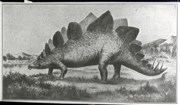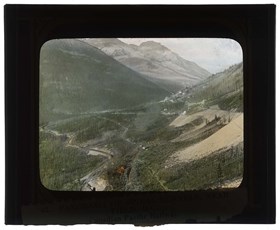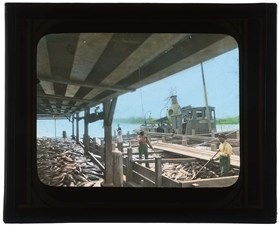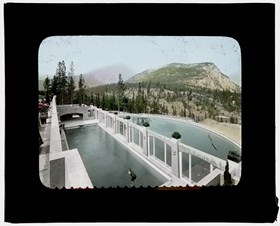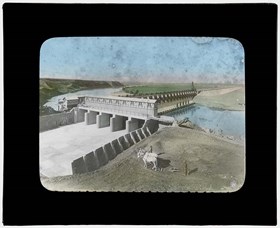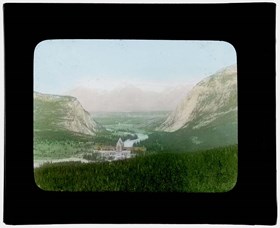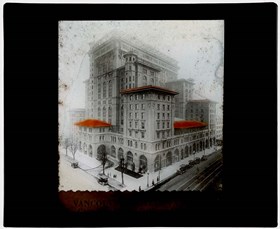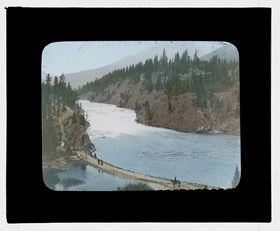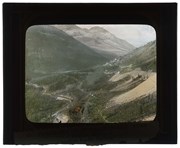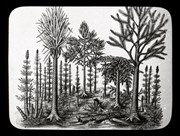Narrow Results By
548. Historical Geography Fig. 512 Restoration of Stegosaurus (After F. A. Lucas)
https://archives.whyte.org/en/permalink/descriptions38908
- Part Of
- Mary Schaffer fonds
- Date Range
- [ca. 1908 - 192-]
- Reference Code
- V527 / PS 1 - 954
- Description Level
- 6 / Item
- GMD
- Photograph
- Lantern slide
- Transparency
1 image
- Part Of
- Mary Schaffer fonds
- Description Level
- 6 / Item
- Series
- II. Photography series
- Sub-Series
- A. Lantern slides 10. World travels
- Reference Code
- V527 / PS 1 - 954
- Date Range
- [ca. 1908 - 192-]
- Physical Description
- 1 transparency : lantern slide
- Subject Access
- Science and technology
- Education
- Geographic Access
- United States of America
Images
This material is presented as originally created; it may contain outdated cultural descriptions and
potentially offensive content.
Read more.
Ben Gadd fonds
https://archives.whyte.org/en/permalink/descriptions55758
- Part Of
- Ben Gadd fonds
- Scope & Content
- Fonds consists of materials pertaining to Ben Gadd's personal life and career as an environmental researcher, educator, interpretive guide, publisher, public speaker and author, ca.1956-2018. Fonds includes maps, research materials, publication notes/drafts, correspondence, contracts, photographs, …
- Date Range
- 1956-2018
- Reference Code
- M590 / V810 / S61
- Description Level
- 1 / Fonds
- GMD
- Digital image
- Drawing
- Negative
- Newspaper clipping
- Photograph
- Photograph print
- Postcard
- Published record
- Textual record
- Video
- Transparency
- Part Of
- Ben Gadd fonds
- Description Level
- 1 / Fonds
- Fonds Number
- M590
- V810
- Sous-Fonds
- M590
- V810
- Accession Number
- 2021.20
- 2024.01
- Reference Code
- M590 / V810 / S61
- GMD
- Digital image
- Drawing
- Negative
- Newspaper clipping
- Photograph
- Photograph print
- Postcard
- Published record
- Textual record
- Video
- Transparency
- Date Range
- 1956-2018
- Physical Description
- ca. 7.9 metres of textual records -- ca. 274 maps -- 29 VHS tapes -- ca.15 discs with digital files -- 21 cassettes -- photographs -- oversized materials -- USB stick with 15 sldeshows
- History / Biographical
- Ben Gadd (1946-) is a retired naturalist, guide, geologist, instructor, freelance writer and award-winning author based in the Canadian Rockies. Ben was born in Colorado Springs, Colorado in 1946. He met his wife, Cia (Langdon) Gadd at Colorado College in 1965, and the couple married four weeks later. Ben and Cia had two sons, Will and Toby. Ben and his family relocated to Jasper in the late 1960s. Ben later attended the University of Lethbridge and graduated with a Bachelor's degree in Earth Science in 1972. Between 1976 and 1980, Ben taught classes at Mount Royal College and the Southern Alberta Institute of Technology; he later taught additional classes at Grant MacEwan College and Lakeland College. From 1981, Ben also worked as a seasonal naturalist/guide for Parks Canada. Ben left Parks Canada in 1985 to start an independent naturalist guiding business with Cia based in Jasper and other parts of the Canadian Rockies, which the couple continued to operate for over two decades. Ben published his best-known work, "Handbook of the Canadian Rockies", through his publishing company Corax Press in 1986. The second edition of "Handbook of the Canadian Rockies" received multiple awards after its release in 1995. Ben's fiction book, "Raven's End" won the title of Best Canadian Rockies Book at the Banff Mountain Film and Book Festival in 2001 and became a Canadian bestseller. Overall, Ben has authored or co-authored 11 books and received nearly one dozen awards for his achievements as a writer, researcher and guide. Ben continued to lead guided hikes and school programs until his retirement in 2016.
- Scope & Content
- Fonds consists of materials pertaining to Ben Gadd's personal life and career as an environmental researcher, educator, interpretive guide, publisher, public speaker and author, ca.1956-2018. Fonds includes maps, research materials, publication notes/drafts, correspondence, contracts, photographs, video and sound recordings, and other related material. Materials donated in 2024 include one USB stick containing
- Notes
- Ben Gadd fonds arrangement: Series I : Personal records - Subseries A : Travel guides and maps - Subseries B : Education and early writings - Subseries C : Personal interest files - Subseries D : Other personal and collected Series II : Research and publication records - Subseries A : Handbook of the Canadian Rockies - Subseries B : Other publications Series III : Professional records - Subseries A : Parks Canada Records - Subseries B : Interpretive guiding - Subseries C : Teaching records - Subseries D : Other contracts and projects Series IV : Legal and financial records - Subseries A : Legal records - Subseries B : Financial records
- Subject Access
- Education
- Research
- Publication
- Environment
- Geology
- Tourism
- Family and personal life
- Personal and Professional Life
- Academics
- Guiding
- Guides
- Businesses
- Finances
- Conservation
- Wildlife
- Natural history
- Sports and recreation
- Geographic Access
- Canada
- Alberta
- Jasper National Park
- Banff National Park
- Yoho National Park
- Kootenay National Park
- Lethbridge
- United States of America
- Colorado
- Canadian Rocky Mountains
- Reproduction Restrictions
- Copyright restrictions apply
- Language
- English
- French
- Dutch
- Title Source
- Title based on contents of fonds
- Processing Status
- Processed / Unprocessed
This material is presented as originally created; it may contain outdated cultural descriptions and
potentially offensive content.
Read more.
Bill Baxter fonds
https://archives.whyte.org/en/permalink/descriptions55699
- Part Of
- Bill Baxter fonds
- Scope & Content
- File consists of 21 plastic binders, one booklet, research notes and newspaper clippings pertaining to geophysical reports and natural resource and mining information within Alberta, 1986-1994. Binders were collected by Bill Baxter as part of his work as a chairperson for the Undermining Review Com…
- Date Range
- 1982-1997
- Reference Code
- M586 / V807
- Description Level
- 1 / Fonds
- GMD
- Textual record
- Corporate record
- Map
- Plan
- Transparency
- Part Of
- Bill Baxter fonds
- Description Level
- 1 / Fonds
- Fonds Number
- M586 / V807
- Sous-Fonds
- M586 / V807
- Accession Number
- 2021.25
- Reference Code
- M586 / V807
- Date Range
- 1982-1997
- Physical Description
- ca.45 cm of textual records -- 2 transparency slides : col. ; 27 x 30 cm -- 6 maps : plastic overlay plans
- History / Biographical
- Bill Baxter (1949-1998) was a geologist in Canmore and Calgary, AB.
- Scope & Content
- File consists of 21 plastic binders, one booklet, research notes and newspaper clippings pertaining to geophysical reports and natural resource and mining information within Alberta, 1986-1994. Binders were collected by Bill Baxter as part of his work as a chairperson for the Undermining Review Committee in Canmore. File also contains two transparency slides from a presentation related to undermining, and 6 architectural layover maps of a mine.
- Name Access
- Baxter, Bill
- Subject Access
- Environment
- Natural resources
- Townsite development
- Land use
- Geographic Access
- Canada
- Alberta
- Canmore
- Reproduction Restrictions
- Copyright status unknown
- Language
- English
- Title Source
- Title based on contents of fonds
- Processing Status
- Processed
This material is presented as originally created; it may contain outdated cultural descriptions and
potentially offensive content.
Read more.
Bill Gibbons fonds
https://archives.whyte.org/en/permalink/descriptions582
- Part Of
- Bill Gibbons fonds
- Scope & Content
- Fonds consists of photographic business records of professional photographer Bill Gibbons in three series: I. Commercial black and white series, ca.1945-ca.1958, ca.5400 photographs; II. Canadian Rockies colour series, ca.1945-ca.1990, predominant ca.1966-ca.1972, ca.8000 photographs; III. Other …
- Date Range
- [ca.1945-ca.1990]
- Reference Code
- M532 / V227
- Description Level
- 1 / Fonds
- GMD
- Photograph
- Negative
- Photograph print
- Postcard
- Transparency
- Textual record
- Private record
- Part Of
- Bill Gibbons fonds
- Description Level
- 1 / Fonds
- Fonds Number
- M 532
- V 227
- Sous-Fonds
- M 532
- V 227
- Accession Number
- 194, 275, 1991, 2020, 5753, 5756, 6760, 7936, 7237
- Reference Code
- M532 / V227
- Responsibility
- Fonds consists of the private business records of Bill Gibbons. Some photographs may have been made by employees.
- Date Range
- [ca.1945-ca.1990]
- Physical Description
- ca.13,404 photographs: negatives, prints, transparencies, albums, postcards. -- 2.5 cm textual records
- History / Biographical
- W. J. L. "Bill" Gibbons, 1914-1994 , was a professional photographer at Banff, Alberta, Canada from 1945 until 1959. Gibbons came to Canada in 1941 and settled in Banff after the war with his wife, Ella Mae (Becker), a Banff native. He established British Photographic Laboratories, with partners Lou Crosby and Jack Anderson, in the basement of the Mount Royal Hotel, moving later to street-level. Bill and Ella Mae Gibbons travelled throughout the mountain parks photographing views for sale in the Banff shop. These were offered as hand-coloured prints, with much of the colouring done or supervised by Ella Mae.
- Later the business expanded to include colour postcards and slide sets. Gibbons employed other photographers, such as Bruno Engler, for specialty work, such as ski photography, and the Banff studio also did portraiture. Gibbons himself did most of the 4 x 5 format landscape work and made extensive use of models, many of who were young women employed by his Banff store. In 1959, Gibbons sold his business to a group of Banff businessmen and moved to Vancouver. In subsequent years, he continued to be active as a photographer and in publishing, working in different areas of the world. He made several photographic trips through the mountain parks, ca.1966-1972.
- Scope & Content
- Fonds consists of photographic business records of professional photographer Bill Gibbons in three series: I. Commercial black and white series, ca.1945-ca.1958, ca.5400 photographs; II. Canadian Rockies colour series, ca.1945-ca.1990, predominant ca.1966-ca.1972, ca.8000 photographs; III. Other black and white series, ca. 1947, 4 photographs.
- I. Commercial black and white series consists of six sub-series: A. Portraits and documentary views, 1945-1950, 2437 negatives (individual and group portraits, weddings, conferences, events, buildings, facilities and places; Banff and area); B. Banff School of Fine Arts, ca.1949, 277 negatives (privately produced views of classes, group portraits, activities, buildings and facilities); C. "S" sub-series, ca.1950, 1220 negatives (scenic views in the vicinity of Banff, Lake Louise, Banff-Jasper Highway, Jasper National Park, Radium and Columbia Valley, British Columbia and Pacific Coast, First Nations views); D. "T" sub-series, ca.1950, 482 negatives (scenic and commercial views, mainly Jasper, Banff-Jasper Highway and Lake Louise areas); E. Rolliflex and panorama negatives, 1949-1958, 584 negatives (Banff Winter Carnival, Banff School of Fine Arts, and Banff and area); F. Other, ca.1945-1951, 364 items (material similar to that in other series, some unidentified). Accompanied by small number of prints and postcards; also, publication: "Photographing the Canadian Rockies" by Bill J. L. Gibbons, 1948.
- II. Canadian Rockies colour series consists of four sub-series: A. CR1 to CR84, ca.1966-ca.1972, ca.260 prints; B. CR1 to CR443, ca.1966-ca.1972, ca.5130 photographs; C. CR35-2 to CR35-81, ca.1966-ca.1972, ca.2310 photographs; D. Other photographs, ca.1945-ca.1990. Series consists primarily of commercial colour negatives and corresponding proof prints pertaining to Banff, Jasper and Yoho National Parks, also some transparencies and oversize display prints.
- III. Other black and white series. Series consists of 2 black and white prints of crash landing at Sunshine with Al Gaetz and Dick Pike, 1947 and two copy negatives with prints of Bruno Engler and Ella Mae Gibbons, ca.1947.
- Textual records are record book, 1945-1953, 62 p; and book layout.
- Name Access
- Gibbons, Bill
- Subject Access
- Arts
- Buildings and facilities
- Commerce and industry
- Education
- Environment
- Family and personal life
- Sports, recreation and leisure
- Access Restrictions
- Some restriction/s on access
- Copyright, privacy, commercial use and other restrictions may apply
- Language
- Language is English
- Finding Aid
- Finding aids and reference tools: arrangement outline
- series and file description
- electronic finding aid
- selected modern reference prints
- Creator
- Gibbons, Bill
- Category
- Arts
- Commerce and industry
- Education
- Environment
- Family and personal life
- Sports, recreation and leisure
- Title Source
- Title based on accession records and contents of fonds
- Processing Status
- Processed
This material is presented as originally created; it may contain outdated cultural descriptions and
potentially offensive content.
Read more.
Canadian Pacific Railway Lantern Slides
https://archives.whyte.org/en/permalink/descriptions16400
- Part Of
- Archives General File Collection
- Scope & Content
- Series consists of 14 lantern slides [ca.1900-ca.1925]. Slides are views along the Canadian Pacific Railway.
- Date Range
- [c. 1905]
- Reference Code
- V8 / 5486 / PS - 1 to PS - 14
- Description Level
- 3 / Series
- GMD
- Transparency
- Lantern slide
14 images
- Part Of
- Archives General File Collection
- Description Level
- 3 / Series
- Fonds Number
- M8 / V8 / S8
- Series
- Accession Number: 5486
- Sous-Fonds
- V8
- Accession Number
- 5486
- Reference Code
- V8 / 5486 / PS - 1 to PS - 14
- Date Range
- [c. 1905]
- Physical Description
- 14 photographs : b&w and col. slides ; 10.2 x 8.2 cm
- History / Biographical
- The Canadian Pacific Railway (CPR) was officially formed in Februray, 1881, to construct a railroad that would link the eastern provinces with British Columbia, a key component of the Canadian Confederation of 1867. Headed by William C. Van Horne as General Manager, the railroad arrived in the Canadian Rockies in 1883 and a siding was established just east of present-day Banff. When railroad workers discovered a natural hot spring on the south side of the Bow River, Van Horne ordered the construction of a hotel that would house visitors brought in by train to visit the springs. Construction of the Banff Springs Hotel finished in 1888 and joined a handful of CPR hotels throughout the Rocky and Selkirk Mountain ranges. The popularity of the hot springs and surrounding area led to the formation of a national park and to the town of Banff. After construction of the railway had completed, the CPR continued to survey and document the Rocky Mountains alongside federal agencies like the Department of the Interior and private outfitters. Utilizing coloured lantern slides the CPR was able to showcase the mountains as both tourist and settlement destinations. Magic lantern shows of these slides could be used for administrative purposes by the company to showcase land holdings and investments or in public shows as advertisements of the new railway.
- Scope & Content
- Series consists of 14 lantern slides [ca.1900-ca.1925]. Slides are views along the Canadian Pacific Railway.
- Name Access
- Canadian Pacific Railway
- Subject Access
- Lantern slide
- Education
- Tourism
- Travel and Exploration
- Trains
- Geographic Access
- Banff
- Lake Louise
- Alberta
- British Columbia
- Canada
- Language
- English
- Conservation
- All slides were cleaned prior to scanning.
- Creator
- Canadian Pacific Railway
- Biographical Source Notes
- https://cpconnectingcanada.ca/#building-the-railway
- Title Source
- Title based on contents of series
- Processing Status
- Processed
Images
This material is presented as originally created; it may contain outdated cultural descriptions and
potentially offensive content.
Read more.
Charlie Russell fonds
https://archives.whyte.org/en/permalink/descriptions643
- Part Of
- Charlie Russell fonds
- Scope & Content
- The Charlie Russell fonds consists of photographs pertaining to the filming of "Grizzly Country", ranching, friends and family, wildlife, and recreational activities, ca.1961-ca.1968. The majority of the images were made in the Waterton Lakes area. There are some images made in New York City, Briti…
- Date Range
- ca.1961-ca.1968
- Reference Code
- V557
- Description Level
- 1 / Fonds
- GMD
- Photograph
- Negative
- Transparency
- Part Of
- Charlie Russell fonds
- Description Level
- 1 / Fonds
- Fonds Number
- V 557
- Sous-Fonds
- V557
- Accession Number
- 7728
- Reference Code
- V557
- Date Range
- ca.1961-ca.1968
- Physical Description
- ca. 2520 photographs : b&w negatives ; 35 mm and 4x5, 2 transparencies; col.
- History / Biographical
- Andrew Charles "Charlie" Russell (August 19, 1941 – May 7, 2018) was a naturalist, photographer, pilot, wilderness guide, and rancher. One of the son's of Andy Russell and Kay Russell and grandson of Bert Riggall, Charlie grew up at the Hawk's Nest ranch on the N.E. boundary of Waterton Lake National Park.
- Alongside his brother Dick Russell, Charlie assisted his father Andy in the production and filming of Grizzly Country throughout the Canadian Rockies, British Columbia, and Alaska from 1961-1964. In 1967 he returned to the Tolkat River in Alaska to photograph and observe bears alone. In 1970 he purchased a large percentage of his fathers land on Waterton's north-east border to run a cattle operation. In 1991, he made his first visit to Princess Royal Island, British Columbia, and began photographing for "Spirit Bear", a book of photographs and writings published in 1994. Beginning in 1997, Charlie spent 6 years among the grizzlies of Kamchatka Peninsula in eastern Russia alongside artist and partner Maureen Enns. After returning to Alberta from Russia, Charlie continued to be a conservation advocate until he passed from a surgery-related complication in May 2018.
- The bulk of Charlie Russell's work was destroyed in a house fire in [1991?].
- Scope & Content
- The Charlie Russell fonds consists of photographs pertaining to the filming of "Grizzly Country", ranching, friends and family, wildlife, and recreational activities, ca.1961-ca.1968. The majority of the images were made in the Waterton Lakes area. There are some images made in New York City, British Columbia, and Alaska. The fonds is comprised of two series: I. Black and white negatives; II. Transparencies; I. Black and white negatives consists of A. 1964, B. Waterton Park Flood, June 8-9, 1963, C. 35mm Books, D. 4x5 Book, E. Bert Riggall Copy Negatives. II. Transparencies consist of two 4x5 colour transparencies depicting Cal Wellman's Cattle.
- Notes
- I.C. was received in the form of three separate negative books. The books have been arranged numerically in subseries I.C, with the negative book book and page number of origin written on the negative sleeves. For example, V557/I/C/NA-1a to NA-6e [Book 1, pg. 1,2].
- Select 35mm negatives in I.C. are marked with red stickers and overlaid with rectangles on the negative sleeve. These negatives correspond to the negatives used in "Spirit Bear" and their cropping for publication. Each image is listed and described in the case file on the document titled "These are the negs used in Spirit Bear Chapter One". Some of the dots have a number corresponding to the document, others do not (the stickers were taken from the original negative sleeves and re-applied to the new negative sleeves).
- Subject Access
- Environment
- Sports, recreation and leisure
- Science and technology
- Natural resources
- Education
- Hawk's Nest Ranch
- Bears
- Wildlife
- Geographic Access
- Waterton Lakes National Park
- Mount McKinley
- Canada
- Alberta
- Alaska
- British Columbia
- United States of America
- Language
- English
- Finding Aid
- Revised digital and original handwritten in case file
- Related Material
- Related by provenance to a portion of Andy Russell fonds.
- Creator
- Russell, Charlie
- Category
- Education
- Environment
- Sports, recreation and leisure
- Science and technology
- Natural resources
- Biographical Source Notes
- Accession record.
- Handwritten documents in case file.
- "Spirit Bear, Encounters with the White Bear of the Western Rainforest", Charlie Russell, 1994, Key Porter Books Limited. Pg 12-25.
- https://charlierussellbears.com/
- Title Source
- Title based on contents of fonds
- Processing Status
- Processed
This material is presented as originally created; it may contain outdated cultural descriptions and
potentially offensive content.
Read more.
Children's Coloured Lantern Slides
https://archives.whyte.org/en/permalink/descriptions54644
- Part Of
- Archives General File Collection
- Scope & Content
- Series contains 35 children's magic lantern slides done in colour, machine-printed rather than hand-painted. There are 4 distinct grouping of the slides: 2019.88-1-12 depict the story "The Transvaal War" [manufactured in 1895?]. Each slide has 3 seperate images with black borders and are numbered s…
- Date Range
- [c.1895]
- Reference Code
- V8 / 2019.88 / PS - 1 to PS - 35
- Description Level
- 3 / Series
- GMD
- Transparency
- Lantern slide
35 images
- Part Of
- Archives General File Collection
- Description Level
- 3 / Series
- Fonds Number
- M8 / V8 / S8
- Series
- Accession Number : 2019.88
- Sous-Fonds
- V8
- Accession Number
- 2019.88
- Reference Code
- V8 / 2019.88 / PS - 1 to PS - 35
- Date Range
- [c.1895]
- Physical Description
- 35 photographs : col. slides ; 6.5 x 22.5 cm
- History / Biographical
- The Ernst Plank Company (EP) was located in Nerumberg, Germany and operated from 1866 until 1930. The company was known for their production of copper and tin toys, specifically stationary and locomotive toy steam engines and carriages, they also produced a variety of magic lanterns and lantern slides. When they first began producing lantern slides, the standard shape of a slide was a square piece of glass about 8cm x 8cm and, depending on the style of magic lantern being used, may have a wooden frame built around the glass. Styles changed as methods for printing slides and lantern designs advanced – by the 1880’s the wooden frame was removed entirely from the slides and replaced with thin strips of coloured binding tape that protected fingers from the glass edges. Originally, hand painted black silhouette images on glass or wax paper were used to create projected pictures, followed closely by the use of colour paints to create entire scenes. Printed images soon replaced hand-painted slides, allowing for cheaper production and more widespread use. A popular format for commercially manufactured lantern slides was a long piece of glass (usually no more than 23cm long) on which multiple images could be printed in order to tell a smoother story. This allowed for two different kinds of display. The first display has smaller pictures printed in circular or square frames with a solid black border and shown as independent images of a larger narrative with pauses in between. The second display option for these slides is as a panoramic scene with the entire area coloured in (or just with figures displayed like on a stage) so they could seamlessly slide from one side to the other. This long thin kind of slide was ideal for home use and could be easily handled by children. Ernst Plank also produced a toy magic lantern out of lightweight tin that could be lit with a small oil lamp specifically for use by children. Slides meant for that kind of lantern were printed on celluloid or on a single plane of glass with a thin layer of transparent lacquer to protect the image. This created a thinner, more lightweight and less delicate slide ideal for small hands. When a toy magic lantern was purchased it came with 1 or 2 sets (each set consisting of 12 slides) in the lantern’s box, additional sets of a particular theme could be purchased independently. Magic lanterns varied greatly in design and material depending on the use. Professional showmen would have multi-lens lanterns lit by powerful chemicals or high-voltage lightbulbs that would allow them to project clear images onto a large screen for a theater audience. There were also simpler lanterns that could be powered by oil lamps, multi-wick candles, gas lighting, or electricity in the home. One of the most popular themes for slide shows where images from international travel, but domestic scenes, Christmas, and famous historic battles were also very common.
- Scope & Content
- Series contains 35 children's magic lantern slides done in colour, machine-printed rather than hand-painted. There are 4 distinct grouping of the slides:
- 2019.88-1-12 depict the story "The Transvaal War" [manufactured in 1895?]. Each slide has 3 seperate images with black borders and are numbered sequentially so that the showman could keep track. There is no maker's mark, but according to a note placed in the accompanying lantern slide box, this set was made by the Ernst Plank Company. The slides depict protraits of men in various uniforms, battle scenes, and soldiers in uniform. Each silde is bordered with green paper in good condition.
- 2019.88-13-16 are unrelated EP slides bordered in red paper of varying condition. 13 has 4 travel images seperated with a black border; 14 is a long slide showing 4 boys in play dress as a marching band; 15 is a panoramic sea scape with ships and a harbour. A section of the coloured glass along the top slightly to the left of centre has been chipped off; 16 is a panoramic pastoral Dutch scene set in the springtime. The supporting glass piece has been badly damaged and is missing on the left end of the slide.
- 2019.88-17-28 are all travel scenes with 4 images to a slide seperated with a black border and no maker's mark. The images contain a mixture of people, animals, buildings and temples (mainly made from stone), boats, and landscapes from North America, Africa (with an emphasis on Egypt), and what could be either South America or Eurasia. All slides are bordered in red paper of fair to good condition.
- 2019.88-29-35 are unrelated EP slides of various styles bordered in red paper in fair to good condition. 29 depicts 4 caricature portraits with a black border; 30, 32, 34 are long slides with 4 individuals on each that are not seperated from eachother with borders, but are not part of a larger scene; 31, 33, 35 are all panoramic pastoral Dutch scenes set in both springtime and winter.
- Notes
- Accompanying the slides is what appears to be an original lantern slide box, made of wood and covered in faded purple paper with a steam engine train image on the top and a logo containing the intials "E.P." The logo consists of a 4-spoke wheel with wings on either side and 3 stars above. One short end of the box is missing and the sliding lid is either warped or stuck and does not open. A sticky note placed inside the box states that the green-line lantern slides (2019.88/PS-1 to PS-12) accompanied the box.
- Subject Access
- Lantern slide
- Children
- Education
- Entertainment
- Language
- N/A
- Conservation
- New binding tape, supports for broken glass
- Creator
- Ernst Plank Company
- Biographical Source Notes
- https://www.luikerwaal.com/newframe_uk.htm?/merk_ep1_uk.htm
- https://libraries.psu.edu/findingaids/2328.htm#toc
- Title Source
- Title based on contents of series.
- Processing Status
- Processed
Images
This material is presented as originally created; it may contain outdated cultural descriptions and
potentially offensive content.
Read more.
Children's Lantern Slides
https://archives.whyte.org/en/permalink/descriptions54775
- Part Of
- Nicholas Morant fonds
- Scope & Content
- File consists of 3 seperate series of coloured, machine printed lantern slides: PS-1 to PS-12 is a collection made by Gebruder Bing, Nurnberg (GBN Bavaria), Decalcomania, Germany. [1] How to kill an annoying mosquito [2] An awful accident in the snow [3] A naughty boy deserves to be punished... …
- Date Range
- [ca. 1895]
- Reference Code
- V500 / III / D / 5 / PS - 1 to PS - 19
- Description Level
- 5 / File
- GMD
- Lantern slide
- Transparency
19 images
- Part Of
- Nicholas Morant fonds
- Description Level
- 5 / File
- Fonds Number
- M300 / S20 / V500
- Sous-Fonds
- V500
- Sub-Series
- V500 / III / D / 5 : Personal Interest and Gifts
- Accession Number
- .
- Reference Code
- V500 / III / D / 5 / PS - 1 to PS - 19
- Date Range
- [ca. 1895]
- Physical Description
- 19 photographs : col. slides ; 22.5cm x 6.5 cm or smaller
- History / Biographical
- See fonds level description.
- Scope & Content
- File consists of 3 seperate series of coloured, machine printed lantern slides:
- PS-1 to PS-12 is a collection made by Gebruder Bing, Nurnberg (GBN Bavaria), Decalcomania, Germany. [1] How to kill an annoying mosquito [2] An awful accident in the snow [3] A naughty boy deserves to be punished... [4] Father Christmas brings you sweets [5] Open your mouth please [6] A Nosey parker [7] A day in the life of a girl [8] Children's games [9] Where do the little children come from? [10] The daily routine of the foxes [11] The frog family takes a bath [12] Animalworld
- PS-13 to PS-18 is a collection called Artistic Series No. 1 made by Gebruder Bing, Nurnberg (GBN Bavaria), Declcomania, Germany. [13] Caricature (slide 2 in original order) [14] Pig and Dwarf (slide 5 in original order) [15] The Rider's Misfortune (slide 6 in original order) [16] Children's Quarrel (slide 7 in original order) [17] The Clowns and the Bottle (slide 11 in original order) [18] The Long Nose (slide 12 in original order)
- PS-19 decpicts 5 caricature faces with the maker's mark obscured by a large crack.
- Notes
- Accompanying the slides was a slide box; white with a green removable lid. The box is made of thin cardboard and has wooden supports inside that hold the slides apart from one another. The box is in poor condition, with much of the top layer of white and green paper scratched, stained, and peeled off, especially around the corners. There are no distinguishing marks on or in the box.
- Subject Access
- Lantern slide
- Children
- Education
- Entertainment
- Language
- N/A
- Conservation
- Slides cleaned prior to scanning. Repair binding tape where needed; reinforce slides with flaking images.
- Title Source
- Title based on contents of file.
- Processing Status
- Processed / Unprocessed
Images
This material is presented as originally created; it may contain outdated cultural descriptions and
potentially offensive content.
Read more.
Coal Measures forest
https://archives.whyte.org/en/permalink/descriptions38910
- Part Of
- Mary Schaffer fonds
- Date Range
- [ca. 1908 - 192-]
- Reference Code
- V527 / PS 1 - 956
- Description Level
- 6 / Item
- GMD
- Photograph
- Lantern slide
- Transparency
1 image
- Part Of
- Mary Schaffer fonds
- Description Level
- 6 / Item
- Series
- II. Photography series
- Sub-Series
- A. Lantern slides 10. World travels
- Reference Code
- V527 / PS 1 - 956
- Date Range
- [ca. 1908 - 192-]
- Physical Description
- 1 transparency : lantern slide
- Subject Access
- Science and technology
- Education
- Geographic Access
- United States of America
Images
This material is presented as originally created; it may contain outdated cultural descriptions and
potentially offensive content.
Read more.
Dorothy Wardle fonds
https://archives.whyte.org/en/permalink/descriptions398
- Part Of
- Dorothy Wardle fonds
- Scope & Content
- Fonds consists of two sous-fonds: M521 and V75. M521 consists of four series, 154 cm, ca.1870-2002. Series I: Dorothy Wardle Personal Papers, 69.5 cm, ca.1870-2002 (includes Dorothy's written work and research and notes related to Banff). Series II: Wardle Family, 32.5 cm, 1872-1998 (including cor…
- Date Range
- ca.1870-2002
- Reference Code
- M521 / V75
- Description Level
- 1 / Fonds
- GMD
- Photograph
- Album
- Negative
- Photograph print
- Postcard
- Transparency
- Textual record
- Private record
- Published record
- Part Of
- Dorothy Wardle fonds
- Description Level
- 1 / Fonds
- Fonds Number
- M521
- V75
- Sous-Fonds
- M521
- V75
- Accession Number
- 5296, 5391, 7504
- Reference Code
- M521 / V75
- GMD
- Photograph
- Album
- Negative
- Photograph print
- Postcard
- Transparency
- Textual record
- Private record
- Published record
- Date Range
- ca.1870-2002
- Physical Description
- 154 cm of textual records. -- 1304 photographs (1190 prints, 95 negatives, 19 transparencies). -- 6 photograph albums.
- History / Biographical
- The Wardle family was comprised of husband and wife, James Morey Wardle (June 26,1888 - May 18,1971) and Maud Leette (Roney) Wardle (May 24,1889 - December 1,1969), and their one child, Dorothy Hope Wardle (May 23,1919 - July 20,2003). James Wardle, born in Chiliwack, British Columbia, was a civil engineer and public servant. He was the Superintendent of Banff National Park from 1918-1921, Chief Engineer for Parks Canada from 1921-1935, and Deputy Minister of the Interior from 1935-1936. He is primarily known as a highway design engineer, particularly for building the Banff-Windermere, Banff-Lake Louise, and Banff-Jasper highways. He was a councillor for the Municipality of Rockcliffe Park in Ontario and he was the President of the Trail Riders of the Canadian Rockies in Banff from 1925-1929. Mount Wardle in Vermillion was named after him in 1921. James married Leette on November 4, 1913, with whom he had one child, Dorothy. Born in Calgary, Alberta, Dorothy (also known as Dot and Dorie) grew up in Banff, Alberta and Ottawa, Ontario, due to her father's position with the federal government. She was educated at the Mountain School in Banff and at the Elmwood School in Ottawa. All three family members were graduates of Queen's University in Kingston, Ontario. James graduated in 1912 with a Bachelor of Science in Engineering, Leette graduated with a Bachelor's degree, and in 1942, Dorothy also earned a Bachelor's degree. Dorothy was prominent in student life and active in athletics. In 1941, Dorothy became the first woman elected as President of the Alma Mater Society and during her academic career, Dorothy was a member of the Levana Intercollegiate Debative, University Centenary Committee, and Queen’s War Aid Commission. Dorothy spent her career as a freelance writer however, upon graduation she served as the first Secretary-In-Charge of Records at Carleton College (now Carleton University) from 1942-1944 in Ottawa and in the mid-1950s worked as a secretary for the Glenbow Foundation in Calgary. Dorothy pursued a lifelong interest in traveling, art, and antiques. Although she was fiercely proud and protective of Banff and the Park, and remained a volunteer and patron of the Whyte Museum of the Canadian Rockies, Dorothy eventually settled in Sidney, British Columbia and shared an apartment with Sheila Iris Ritchie, with whom Dorothy travelled extensively. After her death in 2003, Dorothy, "Dorie," was laid to rest alongside her parents in the Old Banff Cemetery.
- Scope & Content
- Fonds consists of two sous-fonds: M521 and V75.
- M521 consists of four series, 154 cm, ca.1870-2002. Series I: Dorothy Wardle Personal Papers, 69.5 cm, ca.1870-2002 (includes Dorothy's written work and research and notes related to Banff). Series II: Wardle Family, 32.5 cm, 1872-1998 (including correspondence with Carl Rungius and Mrs. Helen Brett, and Christmas and other greeting cards from Peter and Catharine Whyte). Series III: Queen's University, 7.5 cm, 1911-1980 (including graduation certificates for each family member and records pertaining to Dorothy's participation on the Alma Mater Society). Series IV: Travel, 44.5 cm, ca.1950-1988 (includes hand-written notebooks meticulously detailing their travels).
- V75 consists of two series, 79.5 cm, ca. 1912-2001. Series I: Wardle Family, ca. 1912-1971, 6 albums, 31 cm of photograph prints and negatives (including family trips, trail rides in the Canadian Rocky Mountains, and family gatherings). Series II: Dorothy Wardle, 1972-2001, 34 cm of photograph prints, negatives, and transparencies (including Dorothy's travels in Alberta and British Columbia, overseas, and various outings with friends).
- Name Access
- Wardle, Dorothy
- Wardle, James
- Rungius, Carl
- Brett, Helen
- Keyte, Freeman
- Hart, E. J. (Ted)
- Harkin, J. B. (James Bernard)
- Brewster, Pat
- Peyto, Bill
- Brett, Robert George
- Sanson, Norman
- White, Clifford
- Drummond-Davies, Nora
- Mills, Ike
- McLean, George
- Walking Buffalo (George McLean)
- Kaquitts, Frank
- Oxborough, Dorothy
- Whyte, Jon
- Robinson, Dean
- Warren, Mary Schaffer
- Simpson, George
- Gibbon, John Murray
- Whyte, Catharine
- Whyte, Peter
- Greenham, Margaret
- Subject Access
- Arts
- Environment
- Personal and Family Life
- Banff
- Old Banff Cemetery
- Whyte Museum of the Canadian Rockies
- Cabins
- Travel
- Picnics and picnicking
- Holidays
- Scenery
- Christmas
- Dogs
- Horses
- Mountain
- Canoes and canoeing
- Hiking
- Wildlife
- War Memorial
- Highland Games
- Bow River Bridge
- Golfing
- Anniversary
- Horseback riding
- Indigenous Peoples
- Stoney Nakoda
- Education
- Snowshoes and snowshoeing
- Banff Winter Carnival
- Banff Winter Festival
- Women
- Trails
- Trail Riders of the Canadian Rockies
- Sports and leisure
- Skiing
- European travel
- Beach
- Calgary Herald
- Geography
- Government
- Newspaper
- Politics
- Research
- Banff Public Library
- National parks and reserves
- Park policy
- Parks Canada
- Wardens
- Ya-Ha-Tinda Ranch
- Community life
- Mines and mineral resources
- History
- Immigration and homesteading
- Settlement
- Organizations
- World War II
- Biographical
- Professional and Personal Life
- Grizzly Bears
- Fire fighters
- Sunshine Village
- Teahouses
- Banff Indian Days
- Regalia
- Calgary Stampede
- Mountain guides
- Mountain School
- The Albertan
- Crag and Canyon newspaper
- Homestead Hotel
- Banff Centre
- Hot Springs
- Superintendents
- Automobiles
- Natural history
- Records
- Calendar
- Finances
- Leases
- Legal and Financial
- Property
- Recreation
- Geographic Access
- Banff
- Banff National Park
- Canmore
- Alberta
- Canada
- Canadian Rocky Mountains
- Castle Mountain
- Bankhead
- British Columbia
- Glacier National Park
- Kootenay National Park
- Silver City
- Victoria
- Scotland
- Revelstoke
- Yoho National Park
- Ottawa
- Ontario
- Prince Edward Island
- Plain of Six Glaciers
- Lake Agnes
- Lake Louise
- Lake Minnewanka
- Lake O'Hara
- Bow River
- Calgary
- Sidney
- San Francisco
- United States
- Europe
- Germany
- Switzerland
- France
- Spain
- Monaco
- Italy
- Denmark
- Austria
- Quebec
- Windermere
- New York
- Assiniboine
- Ghost River
- High River
- Quebec City
- New Brunswick
- Maine
- Great Divide
- Moraine Lake
- Maligne Lake
- Columbia Icefield
- Washington
- Philadelphia
- Atlantic City
- Larch Valley
- Cascade Mountain
- Panama
- Sulphur Mountain
- Field
- Emerald Lake
- Head Smashed In Buffalo Jump
- Takkakaw Falls
- Jasper National Park
- Athabasca Falls
- Okanagan
- Kananaskis
- Hoodoos
- Powell River
- Montreal
- Access Restrictions
- Some restriction/s on access
- Copyright, privacy, commercial use and other restrictions may apply
- Language
- Language is English
- Related Material
- Dorothy also donated artwork (by Carl Rungius) to Art and Heritage.
- James Morey Wardle fonds (Library and Archives Canada)
- Category
- Arts
- Environment
- Education
- Exploration, discovery and travel
- Family and personal life
- First nations
- Sports, recreation and leisure
- Title Source
- Title based on accession records and contents of fonds
- Processing Status
- Processed
This material is presented as originally created; it may contain outdated cultural descriptions and
potentially offensive content.
Read more.

